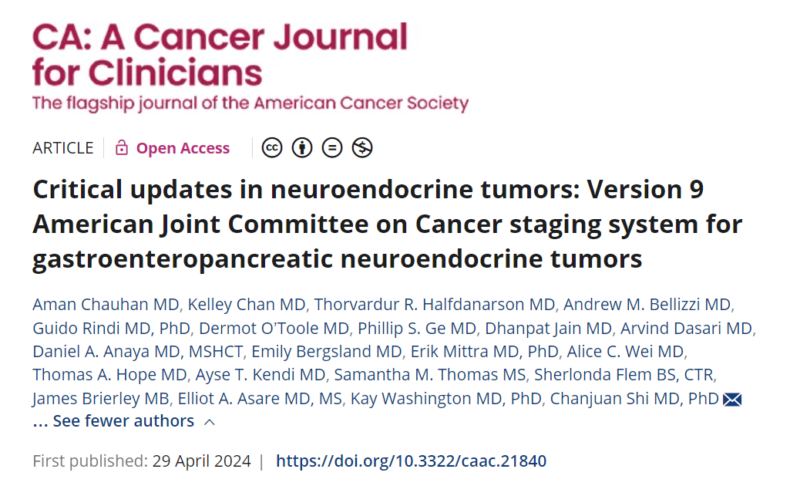
Neuroendocrine tumors – newly updated AJCC guidelines
Newly updated guidelines on neuroendocrine tumors developed by an expert at Sylvester Comprehensive Cancer Center at the University of Miami Miller School of Medicine and collaborators provide clinicians with the latest recommendations for staging and management of these rare but increasingly diagnosed tumors.
The guidelines, developed for the American Joint Committee on Cancer (AJCC) and summarized today in CA: A Cancer Journal for Clinicians, highlight recent changes for treating these tumors and offer a snapshot of this rapidly evolving field.
‘There’s a lot that goes into cancer staging,’ explained Aman Chauhan, M.D., who leads Sylvester’s recently established Neuroendocrine Tumor Program and was first author of the article. ‘Survival and outcome rates and key changes in how we diagnose these tumors are all factors that affect their staging.’ .
‘This is the result of teamwork,’ said Chanjuan Shi, M.D., Ph.D., chief of Gastrointestinal Pathology Service at Duke University School of Medicine, who led the AJCC neuroendocrine tumor version 9 expert panel and was the senior author of the article.
‘The expert panel members, including Dr. Chauhan, have provided critical input into the development of this updated AJCC staging system.’
Neuroendocrine tumors are cancers that form from specialized cells throughout the body that have traits similar to nerve and hormone-producing cells. Although the tumors can occur anywhere within the body, they typically arise in the digestive system or pancreas and often are diagnosed when they produce excess hormones leading to symptoms such as skin flushing, rash, gastrointestinal upset and fatigue.
Although neuroendocrine tumors are still considered rare, their incidence is rising in the U.S., from 1 in 100,000 during the 1970s to around 8 in 100,00 today. ‘We don’t know if the increase is due to improved diagnostic methods developed over the decades or if the cancer itself is becoming more common,’ Chauhan said.
He noted that researchers have linked common medications for acid reflux known as proton pump inhibitors to increased rates of gastric neuroendocrine tumors.
Chauhan, who recently led a collaboration between Sylvester and the North American Neuroendocrine Tumor Society (NANETS) to present an educational conference on managing these tumors, highlighted several key updates to the guidelines last published in 2018. They include:
- A growing role for endoscopic management of neuroendocrine tumors, decreasing the need for surgery. Many tumors are detected during endoscopies or colonoscopies and can be removed simultaneously if they are small enough.
- A move away from using chromogranin A (CgA) levels in the blood to screen for this cancer. These blood tests have shown no diagnostic benefit for these tumors.
- Increasing use of a newer PET scan called DOTATATE imaging to stage these cancers. This type of molecular imaging uses radio-labeled peptides that bind to and light a protein often found on the surface of neuroendocrine cells, known as a somatostatin receptor. The technique not only lights all tumors within the body that have this marker, but also pinpoints tiny amounts of cancer often missed by other methods.
- A focus on current outcomes data for neuroendocrine tumors from the National Cancer Database, a nationwide clinical oncology database from the American College of Surgeons.
The guidelines also identify future directions for the field, which Chauhan is helping to steer through his leadership of Sylvester’s new Neuroendocrine Tumor Program, one of the few U.S. programs for neuroendocrine cancers that treats and studies all types of these tumors and merges care and research through a multidisciplinary approach.
Chauhan says the program is fulfilling an unmet need in South Florida and beyond for expertise in neuroendocrine tumors.
He is particularly excited about an emerging area of treatment related to the molecular imaging techniques highlighted in the updated guidelines. Known as theranostics, this method uses the cancer-killing power of radiation to attack tumor cells in a targeted manner.
Radio-labeled peptides are first used with a low level of radiation to ensure that the drug’s target is present on the patient’s tumor. Then, a similar molecule bearing a higher level of radiation is administered as therapy, bringing radiation directly to the diseased cells.
‘This method avoids much of the collateral damage from traditional radiation, which irradiates both cancerous and surrounding healthy cells,’ Chauhan explained.
‘Many cancer treatments, including most chemotherapies, are really shots in the dark. We don’t know if they will help patients before they begin the treatment,’ he continued. ‘That’s the beauty of this approach. It merges precision diagnosis and therapy together.’
Authors: Aman Chauhan, Kelley Chan, Thorvardur R. Halfdanarson, Andrew M. Bellizzi, Guido Rindi, Dermot O’Toole, Phillip S. Ge, Dhanpat Jain, Arvind Dasari, Daniel A. Anaya, Emily Bergsland, Erik Mittra, Alice C. Wei, Thomas A. Hope, Ayse T. Kendi, Samantha M. Thomas, Sherlonda Flem, James Brierley, Elliot A. Asare, Kay Washington, Chanjuan Shi.

-
Challenging the Status Quo in Colorectal Cancer 2024
December 6-8, 2024
-
ESMO 2024 Congress
September 13-17, 2024
-
ASCO Annual Meeting
May 30 - June 4, 2024
-
Yvonne Award 2024
May 31, 2024
-
OncoThon 2024, Online
Feb. 15, 2024
-
Global Summit on War & Cancer 2023, Online
Dec. 14-16, 2023
